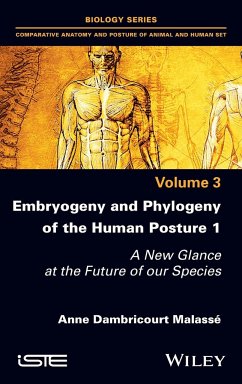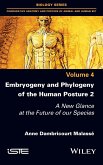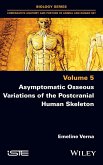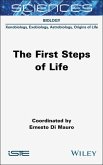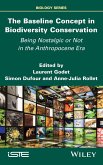Anne Dambricourt Malasse
Embryogeny and Phylogeny of the Human Posture 1
A New Glance at the Future of Our Species
Anne Dambricourt Malasse
Embryogeny and Phylogeny of the Human Posture 1
A New Glance at the Future of Our Species
- Gebundenes Buch
- Merkliste
- Auf die Merkliste
- Bewerten Bewerten
- Teilen
- Produkt teilen
- Produkterinnerung
- Produkterinnerung
The future of the human posture is in the spotlight. The 200-year-old locomotion paradigm can no longer resist the advancement of knowledge, yet 2,500 years of thinking on the place of verticalized human anatomy and its reflexive consciousness in the natural history of life and the Earth, is more relevant than ever. This book retraces these reflections from pre-Socratic philosophers, focusing on the link between verticality and the most complex and consciously reflexive nervous system on the top rung of the ladder of living beings. The origin of animated forms, or animals, was considered…mehr
Andere Kunden interessierten sich auch für
![Embryogeny and Phylogeny of the Human Posture 2 Embryogeny and Phylogeny of the Human Posture 2]() Anne Dambricourt MalasseEmbryogeny and Phylogeny of the Human Posture 2189,99 €
Anne Dambricourt MalasseEmbryogeny and Phylogeny of the Human Posture 2189,99 €![Asymptomatic Osseous Variations of the Postcranial Human Skeleton Asymptomatic Osseous Variations of the Postcranial Human Skeleton]() Emeline VernaAsymptomatic Osseous Variations of the Postcranial Human Skeleton177,99 €
Emeline VernaAsymptomatic Osseous Variations of the Postcranial Human Skeleton177,99 €![Structures and Functions of Retroviral Rnas Structures and Functions of Retroviral Rnas]() Philippe FosseStructures and Functions of Retroviral Rnas176,99 €
Philippe FosseStructures and Functions of Retroviral Rnas176,99 €![Fifty Years of Evolution in Biological Research Fifty Years of Evolution in Biological Research]() Jacques BalthazartFifty Years of Evolution in Biological Research176,99 €
Jacques BalthazartFifty Years of Evolution in Biological Research176,99 €![The First Steps of Life The First Steps of Life]() The First Steps of Life176,99 €
The First Steps of Life176,99 €![The Baseline Concept in Biodiversity Conservation The Baseline Concept in Biodiversity Conservation]() The Baseline Concept in Biodiversity Conservation177,99 €
The Baseline Concept in Biodiversity Conservation177,99 €![Phyllotaxis Models Phyllotaxis Models]() Jean-Paul WalchPhyllotaxis Models177,99 €
Jean-Paul WalchPhyllotaxis Models177,99 €-
-
-
The future of the human posture is in the spotlight. The 200-year-old locomotion paradigm can no longer resist the advancement of knowledge, yet 2,500 years of thinking on the place of verticalized human anatomy and its reflexive consciousness in the natural history of life and the Earth, is more relevant than ever. This book retraces these reflections from pre-Socratic philosophers, focusing on the link between verticality and the most complex and consciously reflexive nervous system on the top rung of the ladder of living beings. The origin of animated forms, or animals, was considered metaphysical until the 19th century but reflection on their inception, from fertilization, paved the way for mathematics of infinitesimal geometry and dynamics. The simian filiation was inconceivable until Jean-Baptiste de Lamarck bridged the gap in 1802 with the locomotion postulate to explain the transition from quadrupedal to bipedal posture, sustained by the hypothesis of inheritance of acquired characteristics. This doctrine was overturned in 1987 by the discovery of the embryonic origins of the straightening - specific dynamics linked to neurogenesis - confirming the natural place of human verticality and nervous system complexity with its psychomotor and cognitive consequences. Sapiens find themselves at the physical limit of the straightening while mechanisms of gametogenesis have never ceased in making neurogenesis exponentially more complex. Is the future exclusively terrestrial or does intrauterine hominization open up new perspectives for space exploration? Posturologists, occlusodontics, osteopaths, cognisciences - all anthropological sciences exposed to human verticality are concerned with this discovery, which allows Sapiens to face their natural destiny
Hinweis: Dieser Artikel kann nur an eine deutsche Lieferadresse ausgeliefert werden.
Hinweis: Dieser Artikel kann nur an eine deutsche Lieferadresse ausgeliefert werden.
Produktdetails
- Produktdetails
- Verlag: Wiley
- Seitenzahl: 256
- Erscheinungstermin: 15. September 2021
- Englisch
- Abmessung: 240mm x 161mm x 18mm
- Gewicht: 554g
- ISBN-13: 9781786306067
- ISBN-10: 1786306069
- Artikelnr.: 62231441
- Herstellerkennzeichnung
- Libri GmbH
- Europaallee 1
- 36244 Bad Hersfeld
- 06621 890
- Verlag: Wiley
- Seitenzahl: 256
- Erscheinungstermin: 15. September 2021
- Englisch
- Abmessung: 240mm x 161mm x 18mm
- Gewicht: 554g
- ISBN-13: 9781786306067
- ISBN-10: 1786306069
- Artikelnr.: 62231441
- Herstellerkennzeichnung
- Libri GmbH
- Europaallee 1
- 36244 Bad Hersfeld
- 06621 890
Anne Dambricourt Malasse is a Paleoanthropologist at the French National Center for Scientific Research (CNRS) attached to the National Museum of Natural History, at the Institut de paléontologie humaine, Paris. She studies the straightening of the nervous system in the primate lineage that leads to human posture and questions its future after having demonstrated its embryonic and phylogenetic origin in 1987.
Preface xi
Part 1. The Vertical Human: Philosopher of Nature 1
Chapter 1. Anthropos, the First of the Animals 3
1.1. Introduction 3
1.1.1. Epistemology according to Georges Cuvier 5
1.1.2. From the metaphysics of beings to the physics of their matter 7
1.1.3. Mathematics, forms and women physicians 10
1.1.4. Socrates, Plato and Aristotle: an anthropology of ideas or a certain
idea of anthropology 13
1.2. Anthropos, the axis of the world 16
1.2.1. Man, a vertical anatomy 16
1.2.2. Apes and humans 17
1.2.3. The generation of anthropos: the father as a model, the mother by
default 20
Chapter 2. From Aristotle to the 16th Century: The Eclipse of Science 27
2.1. Introduction 27
2.2. Comparative anatomy of apes and humans from Aristotle to Galen 27
2.2.1. The Museum of Alexandria 27
2.3. Decadence and rebirth of natural philosophy and human anatomy 31
2.3.1. Albertus Magnus, the Aristotle of a reborn Europe 31
2.3.2. The first lay schools of medicine in Europe in the 11th and 12th
centuries 33
2.3.3. Instant of grace: Leonardo da Vinci, from the elusive movement to
the restitution of the soul 39
Chapter 3. The 16th Century: From Generation to Human Physiology 53
3.1. Ambroise Paré (1510-1590), father of French surgery with "more than
barbaric Latin" 53
3.2. André Vésale (1514-1564), the audacity of objectivity in the face of
Galen's anthropo-simian chimeras 55
3.3. Jacobus Sylvius (1478-1555): defending Galen body and soul 56
3.4. Gabriele Fallope (1523-1562): freedom of dissection, the fine anatomy
of the ear and cranial base 59
3.5. Bartolomeo Eustachi (Bartholomaeus Eustachius, c. 1523-1562): the
human fetus and the monkey 60
3.6. The embryo, the fetus and blood circulation with the maternal body 62
3.6.1. Arantius (1530-1589): the development of the human fetus 62
3.6.2. D'Aquapendente (1533-1619): the father of embryology 62
3.6.3. William Harvey (1578-1657): the demonstration of blood circulation,
vital for the development of the embryo 63
3.7. On human generation and fetal development 64
3.7.1. Gabriel de Zerbis (1455-1505) 65
3.7.2. Volcher Coiter (1534-1576) 65
3.7.3. Félix Platter (Foelix Platerus, 1536-1614), the first optician 66
3.8. Giovanni Alfonso Borelli (1608-1679): the dynamic geometry of the
vertical body 67
Chapter 4. Centuries in Search of Light 69
4.1. Independent Academies of Sciences 69
4.1.1. Gerolamo Cardano: of the necessity and the form of Man, by
spontaneous generation or by putrefaction? 71
4.1.2. Giulio Cesare Vanini (1585-1619), "Prince of the libertines" 75
4.1.3. Man absent from himself, God always as explanation 77
4.2. The beginning of Man and Russian dolls 77
4.2.1. From microscope to microcosm 77
4.2.2. The created species are not immortal 81
Chapter 5. The Century of Naturalistic Enlightenment 85
5.1. The Jardin royal des plantes: a new natural history of animals 85
5.1.1. Georges Leclerc, Count of Buffon 85
5.1.2. A research organization independent of biblical dogmatism 87
5.1.3. The history of the Earth as a premise of the natural history of Man
90
5.1.4. Man is the last "internal mold" created on the Earth 95
5.1.5. The species according to Buffon 100
5.1.6. A fundamental principle: the subordination of external parties to
internal parties 105
Part 2. The Place of Humans among Current and Fossilized Primates 107
Chapter 6. From Natural Curiosity Cabinets to the First Primate Collections
109
6.1. Introduction 109
6.1.1. Conrad Gessner (1516-1565), the first great collector of natural
curiosities 109
6.1.2. Ulisse Aldrovandi (1522-1605), the first natural history museums in
Europe 111
6.1.3. Jacobus Bontius (Jacob de Bondt, 1592-1631): the first wild great
ape or "Man of the Woods" 112
6.1.4. Tulpius (1593-1674), the first description of a chimpanzee 112
6.1.5. Edward Tyson (1650-1708), the first dissection of a chimpanzee 113
6.1.6. Carl Linnaeus (1707-1778), the classification of organisms by
species and genera 116
6.2. Comparative anatomy at the Muséum national d'Histoire naturelle 118
6.2.1. Louis-Jean-Marie Daubenton (1716-1799), the occipital hole and the
face unified by geometry 118
6.2.2. Georges Buffon publishes his own "Nomenclature of Apes" 122
6.2.3. Petrus Camper (1722-1789), the first dissection of an orangutan: the
ape does not speak 124
6.2.4. The premises of a gradualist and racial anthropology 125
Chapter 7. The Transition from the 18th to the 19th Century: Birth of
Paleontology and Comparative Anatomy 127
7.1. Oryctography or the study of the disposition of minerals and fossils
in the soil 127
7.1.1. François-Xavier de Burtin (1743-1818), a leading European collector
127
7.1.2. The French Revolution: naturalist audacity faced with the fury of
the Terror (1792-1794) 128
7.1.3. The premises of the Industrial Revolution: energy and thermodynamics
131
7.2. Georges Cuvier (1769-1832), the French Revolution and the revolution
of the globe 134
7.2.1. The natural sciences at the heart of the "Terror" 134
7.2.2. Karl Kielmeyer, Georges Cuvier's great comrade and gifted youngster
137
7.2.3. Étienne Geoffroy Saint-Hilaire, the unity of the animal composition
plan 138
7.2.4. The laws of animal oeconomy 139
7.2.5. Humans have no fossil ancestor according to Cuvier 141
7.2.6. The division between Cuvier and Geoffroy Saint-Hilaire or the
distinction between micro- and macroevolution 144
Chapter 8. The Slow Recognition of Humans' Simian Origins 147
8.1. Introduction 147
8.2. Jean-Baptiste de Lamarck or the audacity of the transformist theory of
organization plans 148
8.2.1. "The causes of the main physical facts" or "what is life" (1780) 148
8.2.2. Transformism or the first formulation of evolution 150
8.2.3. Lamarck and the first theory of the common origins of the orangutan,
the chimpanzee and Homo sapiens 153
8.2.4. The anatomical origins of Homo sapiens, a break with his own
statements 154
8.2.5. Which system to classify humans: the separation of organizational
plans or the variety of a single plan? 155
Chapter 9. Embryology, Fixist Anthropology and the Neanderthal Man 159
9.1. Introduction 159
9.1.1. The theory of epigenesis (Wolff 1759) 160
9.1.2. Karl von Baer discovers the formation of the ovum (1827) 160
9.1.3. Johann Meckel (1781-1833), the revolution of the 11 laws of
embryogenesis 161
9.2. The origins of the vertical anatomy of humans: between poetic
metaphysics, transcendental finality and climatic influences 164
9.3. Great confusion between Linnaean nesting classification and the
emergence of organizational plans 166
9.3.1. Étienne Serres (1786-1868) and the "transcendental" anatomy of the
embryo (1832) 166
9.3.2. Alfred Velpeau (1795-1867) and the cranio-caudal gradient of
embryogenesis (1832) 168
9.3.3. The first Chair of Embryogeny at the Collège de France (1844) 170
9.3.4. The discovery of the gorilla, 1847-1852 171
9.3.5. Franz Fick (1813-1858), a giant step forward: the study of the
internal base of the skull (1853-1862) 172
9.3.6. Rudolf Virchow (1821-1902), a major study on the relations between
the internal base and the external face 174
9.3.7. Neanderthal Man (1856), a lost human species 175
9.3.8. Herman Welcker (1822-1897), comparative internal growth of the
orangutan and Homo sapiens (1862) 175
Chapter 10. The Decline of Transformism at the Muséum national d'Histoire
naturelle 177
10.1. The decline of transformism despite the discovery of the first monkey
fossils 177
10.1.1. First manmade objects contemporary to Diluvium, 1842 178
10.1.2. Edouard Lartet: the first great fossil monkey to the rescue of
Cuvier (1856) 179
10.1.3. Paris, capital of transformist anthropology and free thought
(1848-1857) 180
10.2. A theory lacking internal coherence 182
10.2.1. Gradualist classification and discontinuities between fossil
genera: an impasse 182
10.2.2. Charles Darwin (1809-1882) knocked at the door of the French
Academy of Sciences and convinced no one 184
10.2.3. A progression toward scientific formalization of the evolution of
structures: the geometrical study of the skull 188
10.2.4. The cart before the horse: the Linnaean classification of fossils
before understanding of processes 190
10.2.5. The transmission of acquired characteristics and Charles Darwin's
gemmules 194
10.2.6. The faults of Charles Darwin against Armand de Quatrefages 197
Chapter 11. Transformist Paleontology Inaugurates the 20th Century 203
11.1. The rebirth 203
11.1.1. Albert Gaudry (1827-1908), a palace in the Jardin des plantes for
paleontology and comparative anatomy 203
11.1.2. Paul Gervais (1816-1879) at the Chair of Anatomy and the first
bipedal fossil monkey 204
11.1.3. Haeckel (1834-1919), on the way to formalizing processes 205
11.1.4. Haeckel, a new hope 207
11.1.5. Phylogenesis and embryogenesis, a reversed logic 209
11.2. Natural selection and the scale of human societies 211
References 215
Index 227
Part 1. The Vertical Human: Philosopher of Nature 1
Chapter 1. Anthropos, the First of the Animals 3
1.1. Introduction 3
1.1.1. Epistemology according to Georges Cuvier 5
1.1.2. From the metaphysics of beings to the physics of their matter 7
1.1.3. Mathematics, forms and women physicians 10
1.1.4. Socrates, Plato and Aristotle: an anthropology of ideas or a certain
idea of anthropology 13
1.2. Anthropos, the axis of the world 16
1.2.1. Man, a vertical anatomy 16
1.2.2. Apes and humans 17
1.2.3. The generation of anthropos: the father as a model, the mother by
default 20
Chapter 2. From Aristotle to the 16th Century: The Eclipse of Science 27
2.1. Introduction 27
2.2. Comparative anatomy of apes and humans from Aristotle to Galen 27
2.2.1. The Museum of Alexandria 27
2.3. Decadence and rebirth of natural philosophy and human anatomy 31
2.3.1. Albertus Magnus, the Aristotle of a reborn Europe 31
2.3.2. The first lay schools of medicine in Europe in the 11th and 12th
centuries 33
2.3.3. Instant of grace: Leonardo da Vinci, from the elusive movement to
the restitution of the soul 39
Chapter 3. The 16th Century: From Generation to Human Physiology 53
3.1. Ambroise Paré (1510-1590), father of French surgery with "more than
barbaric Latin" 53
3.2. André Vésale (1514-1564), the audacity of objectivity in the face of
Galen's anthropo-simian chimeras 55
3.3. Jacobus Sylvius (1478-1555): defending Galen body and soul 56
3.4. Gabriele Fallope (1523-1562): freedom of dissection, the fine anatomy
of the ear and cranial base 59
3.5. Bartolomeo Eustachi (Bartholomaeus Eustachius, c. 1523-1562): the
human fetus and the monkey 60
3.6. The embryo, the fetus and blood circulation with the maternal body 62
3.6.1. Arantius (1530-1589): the development of the human fetus 62
3.6.2. D'Aquapendente (1533-1619): the father of embryology 62
3.6.3. William Harvey (1578-1657): the demonstration of blood circulation,
vital for the development of the embryo 63
3.7. On human generation and fetal development 64
3.7.1. Gabriel de Zerbis (1455-1505) 65
3.7.2. Volcher Coiter (1534-1576) 65
3.7.3. Félix Platter (Foelix Platerus, 1536-1614), the first optician 66
3.8. Giovanni Alfonso Borelli (1608-1679): the dynamic geometry of the
vertical body 67
Chapter 4. Centuries in Search of Light 69
4.1. Independent Academies of Sciences 69
4.1.1. Gerolamo Cardano: of the necessity and the form of Man, by
spontaneous generation or by putrefaction? 71
4.1.2. Giulio Cesare Vanini (1585-1619), "Prince of the libertines" 75
4.1.3. Man absent from himself, God always as explanation 77
4.2. The beginning of Man and Russian dolls 77
4.2.1. From microscope to microcosm 77
4.2.2. The created species are not immortal 81
Chapter 5. The Century of Naturalistic Enlightenment 85
5.1. The Jardin royal des plantes: a new natural history of animals 85
5.1.1. Georges Leclerc, Count of Buffon 85
5.1.2. A research organization independent of biblical dogmatism 87
5.1.3. The history of the Earth as a premise of the natural history of Man
90
5.1.4. Man is the last "internal mold" created on the Earth 95
5.1.5. The species according to Buffon 100
5.1.6. A fundamental principle: the subordination of external parties to
internal parties 105
Part 2. The Place of Humans among Current and Fossilized Primates 107
Chapter 6. From Natural Curiosity Cabinets to the First Primate Collections
109
6.1. Introduction 109
6.1.1. Conrad Gessner (1516-1565), the first great collector of natural
curiosities 109
6.1.2. Ulisse Aldrovandi (1522-1605), the first natural history museums in
Europe 111
6.1.3. Jacobus Bontius (Jacob de Bondt, 1592-1631): the first wild great
ape or "Man of the Woods" 112
6.1.4. Tulpius (1593-1674), the first description of a chimpanzee 112
6.1.5. Edward Tyson (1650-1708), the first dissection of a chimpanzee 113
6.1.6. Carl Linnaeus (1707-1778), the classification of organisms by
species and genera 116
6.2. Comparative anatomy at the Muséum national d'Histoire naturelle 118
6.2.1. Louis-Jean-Marie Daubenton (1716-1799), the occipital hole and the
face unified by geometry 118
6.2.2. Georges Buffon publishes his own "Nomenclature of Apes" 122
6.2.3. Petrus Camper (1722-1789), the first dissection of an orangutan: the
ape does not speak 124
6.2.4. The premises of a gradualist and racial anthropology 125
Chapter 7. The Transition from the 18th to the 19th Century: Birth of
Paleontology and Comparative Anatomy 127
7.1. Oryctography or the study of the disposition of minerals and fossils
in the soil 127
7.1.1. François-Xavier de Burtin (1743-1818), a leading European collector
127
7.1.2. The French Revolution: naturalist audacity faced with the fury of
the Terror (1792-1794) 128
7.1.3. The premises of the Industrial Revolution: energy and thermodynamics
131
7.2. Georges Cuvier (1769-1832), the French Revolution and the revolution
of the globe 134
7.2.1. The natural sciences at the heart of the "Terror" 134
7.2.2. Karl Kielmeyer, Georges Cuvier's great comrade and gifted youngster
137
7.2.3. Étienne Geoffroy Saint-Hilaire, the unity of the animal composition
plan 138
7.2.4. The laws of animal oeconomy 139
7.2.5. Humans have no fossil ancestor according to Cuvier 141
7.2.6. The division between Cuvier and Geoffroy Saint-Hilaire or the
distinction between micro- and macroevolution 144
Chapter 8. The Slow Recognition of Humans' Simian Origins 147
8.1. Introduction 147
8.2. Jean-Baptiste de Lamarck or the audacity of the transformist theory of
organization plans 148
8.2.1. "The causes of the main physical facts" or "what is life" (1780) 148
8.2.2. Transformism or the first formulation of evolution 150
8.2.3. Lamarck and the first theory of the common origins of the orangutan,
the chimpanzee and Homo sapiens 153
8.2.4. The anatomical origins of Homo sapiens, a break with his own
statements 154
8.2.5. Which system to classify humans: the separation of organizational
plans or the variety of a single plan? 155
Chapter 9. Embryology, Fixist Anthropology and the Neanderthal Man 159
9.1. Introduction 159
9.1.1. The theory of epigenesis (Wolff 1759) 160
9.1.2. Karl von Baer discovers the formation of the ovum (1827) 160
9.1.3. Johann Meckel (1781-1833), the revolution of the 11 laws of
embryogenesis 161
9.2. The origins of the vertical anatomy of humans: between poetic
metaphysics, transcendental finality and climatic influences 164
9.3. Great confusion between Linnaean nesting classification and the
emergence of organizational plans 166
9.3.1. Étienne Serres (1786-1868) and the "transcendental" anatomy of the
embryo (1832) 166
9.3.2. Alfred Velpeau (1795-1867) and the cranio-caudal gradient of
embryogenesis (1832) 168
9.3.3. The first Chair of Embryogeny at the Collège de France (1844) 170
9.3.4. The discovery of the gorilla, 1847-1852 171
9.3.5. Franz Fick (1813-1858), a giant step forward: the study of the
internal base of the skull (1853-1862) 172
9.3.6. Rudolf Virchow (1821-1902), a major study on the relations between
the internal base and the external face 174
9.3.7. Neanderthal Man (1856), a lost human species 175
9.3.8. Herman Welcker (1822-1897), comparative internal growth of the
orangutan and Homo sapiens (1862) 175
Chapter 10. The Decline of Transformism at the Muséum national d'Histoire
naturelle 177
10.1. The decline of transformism despite the discovery of the first monkey
fossils 177
10.1.1. First manmade objects contemporary to Diluvium, 1842 178
10.1.2. Edouard Lartet: the first great fossil monkey to the rescue of
Cuvier (1856) 179
10.1.3. Paris, capital of transformist anthropology and free thought
(1848-1857) 180
10.2. A theory lacking internal coherence 182
10.2.1. Gradualist classification and discontinuities between fossil
genera: an impasse 182
10.2.2. Charles Darwin (1809-1882) knocked at the door of the French
Academy of Sciences and convinced no one 184
10.2.3. A progression toward scientific formalization of the evolution of
structures: the geometrical study of the skull 188
10.2.4. The cart before the horse: the Linnaean classification of fossils
before understanding of processes 190
10.2.5. The transmission of acquired characteristics and Charles Darwin's
gemmules 194
10.2.6. The faults of Charles Darwin against Armand de Quatrefages 197
Chapter 11. Transformist Paleontology Inaugurates the 20th Century 203
11.1. The rebirth 203
11.1.1. Albert Gaudry (1827-1908), a palace in the Jardin des plantes for
paleontology and comparative anatomy 203
11.1.2. Paul Gervais (1816-1879) at the Chair of Anatomy and the first
bipedal fossil monkey 204
11.1.3. Haeckel (1834-1919), on the way to formalizing processes 205
11.1.4. Haeckel, a new hope 207
11.1.5. Phylogenesis and embryogenesis, a reversed logic 209
11.2. Natural selection and the scale of human societies 211
References 215
Index 227
Preface xi
Part 1. The Vertical Human: Philosopher of Nature 1
Chapter 1. Anthropos, the First of the Animals 3
1.1. Introduction 3
1.1.1. Epistemology according to Georges Cuvier 5
1.1.2. From the metaphysics of beings to the physics of their matter 7
1.1.3. Mathematics, forms and women physicians 10
1.1.4. Socrates, Plato and Aristotle: an anthropology of ideas or a certain
idea of anthropology 13
1.2. Anthropos, the axis of the world 16
1.2.1. Man, a vertical anatomy 16
1.2.2. Apes and humans 17
1.2.3. The generation of anthropos: the father as a model, the mother by
default 20
Chapter 2. From Aristotle to the 16th Century: The Eclipse of Science 27
2.1. Introduction 27
2.2. Comparative anatomy of apes and humans from Aristotle to Galen 27
2.2.1. The Museum of Alexandria 27
2.3. Decadence and rebirth of natural philosophy and human anatomy 31
2.3.1. Albertus Magnus, the Aristotle of a reborn Europe 31
2.3.2. The first lay schools of medicine in Europe in the 11th and 12th
centuries 33
2.3.3. Instant of grace: Leonardo da Vinci, from the elusive movement to
the restitution of the soul 39
Chapter 3. The 16th Century: From Generation to Human Physiology 53
3.1. Ambroise Paré (1510-1590), father of French surgery with "more than
barbaric Latin" 53
3.2. André Vésale (1514-1564), the audacity of objectivity in the face of
Galen's anthropo-simian chimeras 55
3.3. Jacobus Sylvius (1478-1555): defending Galen body and soul 56
3.4. Gabriele Fallope (1523-1562): freedom of dissection, the fine anatomy
of the ear and cranial base 59
3.5. Bartolomeo Eustachi (Bartholomaeus Eustachius, c. 1523-1562): the
human fetus and the monkey 60
3.6. The embryo, the fetus and blood circulation with the maternal body 62
3.6.1. Arantius (1530-1589): the development of the human fetus 62
3.6.2. D'Aquapendente (1533-1619): the father of embryology 62
3.6.3. William Harvey (1578-1657): the demonstration of blood circulation,
vital for the development of the embryo 63
3.7. On human generation and fetal development 64
3.7.1. Gabriel de Zerbis (1455-1505) 65
3.7.2. Volcher Coiter (1534-1576) 65
3.7.3. Félix Platter (Foelix Platerus, 1536-1614), the first optician 66
3.8. Giovanni Alfonso Borelli (1608-1679): the dynamic geometry of the
vertical body 67
Chapter 4. Centuries in Search of Light 69
4.1. Independent Academies of Sciences 69
4.1.1. Gerolamo Cardano: of the necessity and the form of Man, by
spontaneous generation or by putrefaction? 71
4.1.2. Giulio Cesare Vanini (1585-1619), "Prince of the libertines" 75
4.1.3. Man absent from himself, God always as explanation 77
4.2. The beginning of Man and Russian dolls 77
4.2.1. From microscope to microcosm 77
4.2.2. The created species are not immortal 81
Chapter 5. The Century of Naturalistic Enlightenment 85
5.1. The Jardin royal des plantes: a new natural history of animals 85
5.1.1. Georges Leclerc, Count of Buffon 85
5.1.2. A research organization independent of biblical dogmatism 87
5.1.3. The history of the Earth as a premise of the natural history of Man
90
5.1.4. Man is the last "internal mold" created on the Earth 95
5.1.5. The species according to Buffon 100
5.1.6. A fundamental principle: the subordination of external parties to
internal parties 105
Part 2. The Place of Humans among Current and Fossilized Primates 107
Chapter 6. From Natural Curiosity Cabinets to the First Primate Collections
109
6.1. Introduction 109
6.1.1. Conrad Gessner (1516-1565), the first great collector of natural
curiosities 109
6.1.2. Ulisse Aldrovandi (1522-1605), the first natural history museums in
Europe 111
6.1.3. Jacobus Bontius (Jacob de Bondt, 1592-1631): the first wild great
ape or "Man of the Woods" 112
6.1.4. Tulpius (1593-1674), the first description of a chimpanzee 112
6.1.5. Edward Tyson (1650-1708), the first dissection of a chimpanzee 113
6.1.6. Carl Linnaeus (1707-1778), the classification of organisms by
species and genera 116
6.2. Comparative anatomy at the Muséum national d'Histoire naturelle 118
6.2.1. Louis-Jean-Marie Daubenton (1716-1799), the occipital hole and the
face unified by geometry 118
6.2.2. Georges Buffon publishes his own "Nomenclature of Apes" 122
6.2.3. Petrus Camper (1722-1789), the first dissection of an orangutan: the
ape does not speak 124
6.2.4. The premises of a gradualist and racial anthropology 125
Chapter 7. The Transition from the 18th to the 19th Century: Birth of
Paleontology and Comparative Anatomy 127
7.1. Oryctography or the study of the disposition of minerals and fossils
in the soil 127
7.1.1. François-Xavier de Burtin (1743-1818), a leading European collector
127
7.1.2. The French Revolution: naturalist audacity faced with the fury of
the Terror (1792-1794) 128
7.1.3. The premises of the Industrial Revolution: energy and thermodynamics
131
7.2. Georges Cuvier (1769-1832), the French Revolution and the revolution
of the globe 134
7.2.1. The natural sciences at the heart of the "Terror" 134
7.2.2. Karl Kielmeyer, Georges Cuvier's great comrade and gifted youngster
137
7.2.3. Étienne Geoffroy Saint-Hilaire, the unity of the animal composition
plan 138
7.2.4. The laws of animal oeconomy 139
7.2.5. Humans have no fossil ancestor according to Cuvier 141
7.2.6. The division between Cuvier and Geoffroy Saint-Hilaire or the
distinction between micro- and macroevolution 144
Chapter 8. The Slow Recognition of Humans' Simian Origins 147
8.1. Introduction 147
8.2. Jean-Baptiste de Lamarck or the audacity of the transformist theory of
organization plans 148
8.2.1. "The causes of the main physical facts" or "what is life" (1780) 148
8.2.2. Transformism or the first formulation of evolution 150
8.2.3. Lamarck and the first theory of the common origins of the orangutan,
the chimpanzee and Homo sapiens 153
8.2.4. The anatomical origins of Homo sapiens, a break with his own
statements 154
8.2.5. Which system to classify humans: the separation of organizational
plans or the variety of a single plan? 155
Chapter 9. Embryology, Fixist Anthropology and the Neanderthal Man 159
9.1. Introduction 159
9.1.1. The theory of epigenesis (Wolff 1759) 160
9.1.2. Karl von Baer discovers the formation of the ovum (1827) 160
9.1.3. Johann Meckel (1781-1833), the revolution of the 11 laws of
embryogenesis 161
9.2. The origins of the vertical anatomy of humans: between poetic
metaphysics, transcendental finality and climatic influences 164
9.3. Great confusion between Linnaean nesting classification and the
emergence of organizational plans 166
9.3.1. Étienne Serres (1786-1868) and the "transcendental" anatomy of the
embryo (1832) 166
9.3.2. Alfred Velpeau (1795-1867) and the cranio-caudal gradient of
embryogenesis (1832) 168
9.3.3. The first Chair of Embryogeny at the Collège de France (1844) 170
9.3.4. The discovery of the gorilla, 1847-1852 171
9.3.5. Franz Fick (1813-1858), a giant step forward: the study of the
internal base of the skull (1853-1862) 172
9.3.6. Rudolf Virchow (1821-1902), a major study on the relations between
the internal base and the external face 174
9.3.7. Neanderthal Man (1856), a lost human species 175
9.3.8. Herman Welcker (1822-1897), comparative internal growth of the
orangutan and Homo sapiens (1862) 175
Chapter 10. The Decline of Transformism at the Muséum national d'Histoire
naturelle 177
10.1. The decline of transformism despite the discovery of the first monkey
fossils 177
10.1.1. First manmade objects contemporary to Diluvium, 1842 178
10.1.2. Edouard Lartet: the first great fossil monkey to the rescue of
Cuvier (1856) 179
10.1.3. Paris, capital of transformist anthropology and free thought
(1848-1857) 180
10.2. A theory lacking internal coherence 182
10.2.1. Gradualist classification and discontinuities between fossil
genera: an impasse 182
10.2.2. Charles Darwin (1809-1882) knocked at the door of the French
Academy of Sciences and convinced no one 184
10.2.3. A progression toward scientific formalization of the evolution of
structures: the geometrical study of the skull 188
10.2.4. The cart before the horse: the Linnaean classification of fossils
before understanding of processes 190
10.2.5. The transmission of acquired characteristics and Charles Darwin's
gemmules 194
10.2.6. The faults of Charles Darwin against Armand de Quatrefages 197
Chapter 11. Transformist Paleontology Inaugurates the 20th Century 203
11.1. The rebirth 203
11.1.1. Albert Gaudry (1827-1908), a palace in the Jardin des plantes for
paleontology and comparative anatomy 203
11.1.2. Paul Gervais (1816-1879) at the Chair of Anatomy and the first
bipedal fossil monkey 204
11.1.3. Haeckel (1834-1919), on the way to formalizing processes 205
11.1.4. Haeckel, a new hope 207
11.1.5. Phylogenesis and embryogenesis, a reversed logic 209
11.2. Natural selection and the scale of human societies 211
References 215
Index 227
Part 1. The Vertical Human: Philosopher of Nature 1
Chapter 1. Anthropos, the First of the Animals 3
1.1. Introduction 3
1.1.1. Epistemology according to Georges Cuvier 5
1.1.2. From the metaphysics of beings to the physics of their matter 7
1.1.3. Mathematics, forms and women physicians 10
1.1.4. Socrates, Plato and Aristotle: an anthropology of ideas or a certain
idea of anthropology 13
1.2. Anthropos, the axis of the world 16
1.2.1. Man, a vertical anatomy 16
1.2.2. Apes and humans 17
1.2.3. The generation of anthropos: the father as a model, the mother by
default 20
Chapter 2. From Aristotle to the 16th Century: The Eclipse of Science 27
2.1. Introduction 27
2.2. Comparative anatomy of apes and humans from Aristotle to Galen 27
2.2.1. The Museum of Alexandria 27
2.3. Decadence and rebirth of natural philosophy and human anatomy 31
2.3.1. Albertus Magnus, the Aristotle of a reborn Europe 31
2.3.2. The first lay schools of medicine in Europe in the 11th and 12th
centuries 33
2.3.3. Instant of grace: Leonardo da Vinci, from the elusive movement to
the restitution of the soul 39
Chapter 3. The 16th Century: From Generation to Human Physiology 53
3.1. Ambroise Paré (1510-1590), father of French surgery with "more than
barbaric Latin" 53
3.2. André Vésale (1514-1564), the audacity of objectivity in the face of
Galen's anthropo-simian chimeras 55
3.3. Jacobus Sylvius (1478-1555): defending Galen body and soul 56
3.4. Gabriele Fallope (1523-1562): freedom of dissection, the fine anatomy
of the ear and cranial base 59
3.5. Bartolomeo Eustachi (Bartholomaeus Eustachius, c. 1523-1562): the
human fetus and the monkey 60
3.6. The embryo, the fetus and blood circulation with the maternal body 62
3.6.1. Arantius (1530-1589): the development of the human fetus 62
3.6.2. D'Aquapendente (1533-1619): the father of embryology 62
3.6.3. William Harvey (1578-1657): the demonstration of blood circulation,
vital for the development of the embryo 63
3.7. On human generation and fetal development 64
3.7.1. Gabriel de Zerbis (1455-1505) 65
3.7.2. Volcher Coiter (1534-1576) 65
3.7.3. Félix Platter (Foelix Platerus, 1536-1614), the first optician 66
3.8. Giovanni Alfonso Borelli (1608-1679): the dynamic geometry of the
vertical body 67
Chapter 4. Centuries in Search of Light 69
4.1. Independent Academies of Sciences 69
4.1.1. Gerolamo Cardano: of the necessity and the form of Man, by
spontaneous generation or by putrefaction? 71
4.1.2. Giulio Cesare Vanini (1585-1619), "Prince of the libertines" 75
4.1.3. Man absent from himself, God always as explanation 77
4.2. The beginning of Man and Russian dolls 77
4.2.1. From microscope to microcosm 77
4.2.2. The created species are not immortal 81
Chapter 5. The Century of Naturalistic Enlightenment 85
5.1. The Jardin royal des plantes: a new natural history of animals 85
5.1.1. Georges Leclerc, Count of Buffon 85
5.1.2. A research organization independent of biblical dogmatism 87
5.1.3. The history of the Earth as a premise of the natural history of Man
90
5.1.4. Man is the last "internal mold" created on the Earth 95
5.1.5. The species according to Buffon 100
5.1.6. A fundamental principle: the subordination of external parties to
internal parties 105
Part 2. The Place of Humans among Current and Fossilized Primates 107
Chapter 6. From Natural Curiosity Cabinets to the First Primate Collections
109
6.1. Introduction 109
6.1.1. Conrad Gessner (1516-1565), the first great collector of natural
curiosities 109
6.1.2. Ulisse Aldrovandi (1522-1605), the first natural history museums in
Europe 111
6.1.3. Jacobus Bontius (Jacob de Bondt, 1592-1631): the first wild great
ape or "Man of the Woods" 112
6.1.4. Tulpius (1593-1674), the first description of a chimpanzee 112
6.1.5. Edward Tyson (1650-1708), the first dissection of a chimpanzee 113
6.1.6. Carl Linnaeus (1707-1778), the classification of organisms by
species and genera 116
6.2. Comparative anatomy at the Muséum national d'Histoire naturelle 118
6.2.1. Louis-Jean-Marie Daubenton (1716-1799), the occipital hole and the
face unified by geometry 118
6.2.2. Georges Buffon publishes his own "Nomenclature of Apes" 122
6.2.3. Petrus Camper (1722-1789), the first dissection of an orangutan: the
ape does not speak 124
6.2.4. The premises of a gradualist and racial anthropology 125
Chapter 7. The Transition from the 18th to the 19th Century: Birth of
Paleontology and Comparative Anatomy 127
7.1. Oryctography or the study of the disposition of minerals and fossils
in the soil 127
7.1.1. François-Xavier de Burtin (1743-1818), a leading European collector
127
7.1.2. The French Revolution: naturalist audacity faced with the fury of
the Terror (1792-1794) 128
7.1.3. The premises of the Industrial Revolution: energy and thermodynamics
131
7.2. Georges Cuvier (1769-1832), the French Revolution and the revolution
of the globe 134
7.2.1. The natural sciences at the heart of the "Terror" 134
7.2.2. Karl Kielmeyer, Georges Cuvier's great comrade and gifted youngster
137
7.2.3. Étienne Geoffroy Saint-Hilaire, the unity of the animal composition
plan 138
7.2.4. The laws of animal oeconomy 139
7.2.5. Humans have no fossil ancestor according to Cuvier 141
7.2.6. The division between Cuvier and Geoffroy Saint-Hilaire or the
distinction between micro- and macroevolution 144
Chapter 8. The Slow Recognition of Humans' Simian Origins 147
8.1. Introduction 147
8.2. Jean-Baptiste de Lamarck or the audacity of the transformist theory of
organization plans 148
8.2.1. "The causes of the main physical facts" or "what is life" (1780) 148
8.2.2. Transformism or the first formulation of evolution 150
8.2.3. Lamarck and the first theory of the common origins of the orangutan,
the chimpanzee and Homo sapiens 153
8.2.4. The anatomical origins of Homo sapiens, a break with his own
statements 154
8.2.5. Which system to classify humans: the separation of organizational
plans or the variety of a single plan? 155
Chapter 9. Embryology, Fixist Anthropology and the Neanderthal Man 159
9.1. Introduction 159
9.1.1. The theory of epigenesis (Wolff 1759) 160
9.1.2. Karl von Baer discovers the formation of the ovum (1827) 160
9.1.3. Johann Meckel (1781-1833), the revolution of the 11 laws of
embryogenesis 161
9.2. The origins of the vertical anatomy of humans: between poetic
metaphysics, transcendental finality and climatic influences 164
9.3. Great confusion between Linnaean nesting classification and the
emergence of organizational plans 166
9.3.1. Étienne Serres (1786-1868) and the "transcendental" anatomy of the
embryo (1832) 166
9.3.2. Alfred Velpeau (1795-1867) and the cranio-caudal gradient of
embryogenesis (1832) 168
9.3.3. The first Chair of Embryogeny at the Collège de France (1844) 170
9.3.4. The discovery of the gorilla, 1847-1852 171
9.3.5. Franz Fick (1813-1858), a giant step forward: the study of the
internal base of the skull (1853-1862) 172
9.3.6. Rudolf Virchow (1821-1902), a major study on the relations between
the internal base and the external face 174
9.3.7. Neanderthal Man (1856), a lost human species 175
9.3.8. Herman Welcker (1822-1897), comparative internal growth of the
orangutan and Homo sapiens (1862) 175
Chapter 10. The Decline of Transformism at the Muséum national d'Histoire
naturelle 177
10.1. The decline of transformism despite the discovery of the first monkey
fossils 177
10.1.1. First manmade objects contemporary to Diluvium, 1842 178
10.1.2. Edouard Lartet: the first great fossil monkey to the rescue of
Cuvier (1856) 179
10.1.3. Paris, capital of transformist anthropology and free thought
(1848-1857) 180
10.2. A theory lacking internal coherence 182
10.2.1. Gradualist classification and discontinuities between fossil
genera: an impasse 182
10.2.2. Charles Darwin (1809-1882) knocked at the door of the French
Academy of Sciences and convinced no one 184
10.2.3. A progression toward scientific formalization of the evolution of
structures: the geometrical study of the skull 188
10.2.4. The cart before the horse: the Linnaean classification of fossils
before understanding of processes 190
10.2.5. The transmission of acquired characteristics and Charles Darwin's
gemmules 194
10.2.6. The faults of Charles Darwin against Armand de Quatrefages 197
Chapter 11. Transformist Paleontology Inaugurates the 20th Century 203
11.1. The rebirth 203
11.1.1. Albert Gaudry (1827-1908), a palace in the Jardin des plantes for
paleontology and comparative anatomy 203
11.1.2. Paul Gervais (1816-1879) at the Chair of Anatomy and the first
bipedal fossil monkey 204
11.1.3. Haeckel (1834-1919), on the way to formalizing processes 205
11.1.4. Haeckel, a new hope 207
11.1.5. Phylogenesis and embryogenesis, a reversed logic 209
11.2. Natural selection and the scale of human societies 211
References 215
Index 227

